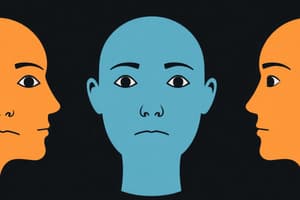Podcast
Questions and Answers
What are the fundamental characteristics of personality?
What are the fundamental characteristics of personality?
Consistency, psychological and physiological traits, impact on behaviors and actions, and multiple expressions.
Which of these options describes the categories proposed by Hippocrates?
Which of these options describes the categories proposed by Hippocrates?
- Choleric (correct)
- Sanguine (correct)
- Phlegmatic (correct)
- Cognitive
- Melancholic (correct)
According to Plato, the appetitive part of the soul controls basic bodily desires.
According to Plato, the appetitive part of the soul controls basic bodily desires.
True (A)
What does the formula R = f(S × P) represent in Cattell's trait theory?
What does the formula R = f(S × P) represent in Cattell's trait theory?
What are the three dimensions of personality proposed by Eysenck?
What are the three dimensions of personality proposed by Eysenck?
According to Eysenck, extraverts are characterized by high levels of ______.
According to Eysenck, extraverts are characterized by high levels of ______.
What are common traits as defined by Cattell?
What are common traits as defined by Cattell?
A unique trait is specific to an individual and cannot be measured for others.
A unique trait is specific to an individual and cannot be measured for others.
Study Notes
Introduction to Personality Theory
- Personality is a unique blend of characteristics, thoughts, feelings, and behaviors that make each individual distinct.
- It arises from within and remains consistent throughout life.
Fundamental Characteristics of Personality
- Consistency: People exhibit predictable and regular behaviors, demonstrating similar responses across diverse situations.
- Psychological and physiological traits: Personality, while a psychological construct, is influenced by biological processes and needs.
- Impact on behaviors and actions: Personality shapes how we interact with our environment and influences our actions.
- Multiple expressions: Personality manifests not only in behavior but also in thoughts, feelings, relationships, and social interactions.
History of Personality Theory
- Hippocrates: The ancient physician categorized people into four distinct personality types: Melancholic (sad), Sanguine (enthusiastic), Choleric (active), and Phlegmatic (calm).
- Plato: According to Plato, the soul has three parts: an appetitive part (basic needs like food and drink), a spirited part (disciplines the other two parts), and a rational part (reasoning, problem solving, and control over the appetitive part).
Four Main Personality Theories
- Trait Theories: These theories propose that individuals possess fundamental personality traits that differ in strength and intensity, explaining personality differences.
- Behavioral Theories: Emphasize the role of learning and environmental influences in shaping personality.
- Humanist Theories: Focus on individual growth, self-actualization, and the pursuit of meaning in life.
- Psychodynamic Theories: Explore the unconscious mind and its impact on personality development and behavior.
Trait-Based Theory
- The trait theory suggests that personality differences are rooted in the strength and intensity of individuals' fundamental traits.
- Trait theorists primarily focus on measuring traits, which are defined as habitual patterns of behavior, thought, and emotion.
Trait-Based Theory: Raymond Cattell
- Cattell believed personality traits are enduring characteristics that influence behavior throughout life (R = f(S × P)).
- Common Traits: These are traits measurable for all people using standardized assessments, with individuals differing in degree rather than type (e.g., openness, extroversion, neuroticism, intelligence).
- Unique Traits: Highly specific traits that distinguish one individual from another.
- Surface Traits: Clearly visible and easily recognizable by others (e.g., friendliness).
- Source Traits: Less noticeable traits that underlie multiple surface traits and represent fundamental personality dimensions.
Trait-Based Theory: Eysenck: “Off the Top of the Head” Theorizing
- Eysenck defined traits as theoretical constructs derived from observed relationships between various habitual responses.
- Eysenck identified three personality dimensions:
- Extraversion-Introversion: Characterized by sociability, positive affect, and differences in cortical stimulation. Extraverts seek stimulation while introverts avoid overstimulation.
- Neuroticism: Related to emotional stability and reactivity.
- Psychoticism: Reflects a tendency towards impulsivity, non-conforming behavior, and a detachment from social norms.
Studying That Suits You
Use AI to generate personalized quizzes and flashcards to suit your learning preferences.
Related Documents
Description
Explore the fundamental characteristics and history of personality theory. This quiz covers the consistency, influences, and manifestations of personality, including historical perspectives from figures like Hippocrates. Test your understanding of how personality shapes individual behaviors and interactions.




